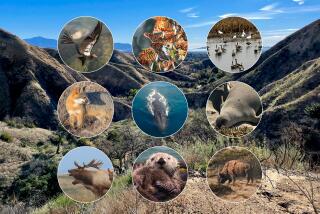Walking amid wings
This yearâs winter rains promise a bountiful butterfly population, and for a close-up view of some of the 170-plus species typically found in Southern California, head down to the Irvine Ranch Land Preserve on Sunday for the latest in the preserveâs ongoing series of butterfly walks.
Now in its third year, the butterfly walk is a monthly 3-mile jaunt that takes about three hours. Thereâs a lot of stopping, pointing and investigating, according to naturalist Liz Cooper, who along with naturalist Sandra Huwe leads the walks.
Raising butterflies at her home, which borders the preserve, Cooper brings in examples of eggs, larvae and chrysalises to show walkers the insectâs life stages. Those stages vary greatly from one species to the next, ranging from some with a life cycle of just a few days to those that take years to gestate and mature. But many mature quickly, so Cooper and Huwe are already seeing the effect of the rains on the local butterfly population. Cooper will bring along her trusty net to catch examples of different species of butterflies for closer inspection during the walk.
âWeâll put the butterfly in a jar and pass it around,â she says. âWeâll talk about that species, find out if itâs male or female, and then release it.â
Additionally, backyard gardeners will get plenty of tips on plants that can attract butterflies. âWeâll also talk about the difference between host and nectar plants,â Cooper says, explaining that a host plant is one that butterflies lay their eggs on; nectar plants are what they eat. For example, monarch butterflies lay their eggs only on milkweed but will drink nectar from a variety of plants.
Itâs important to be able to recognize a speciesâ distinguishing marks, she says, but it really helps to know the host plants a butterfly lays eggs on. Because some butterfliesâ life spans are amazingly short -- some only a few days -- they spend most of their time near host plants, laying eggs.
Cooper uses the walks in part to focus attention on habitat destruction.
âOur goal for people is not that they get good at identifying butterflies, but that they have a basic understanding of butterflies and the importance of protecting our native habitat,â Cooper says. âWhen we eliminate grasslands and wetlands, we diminish the homes of these magnificent creatures.â
*
Butterfly walk
Baker Canyon, Irvine Ranch Land Reserve, 2883 Irvine Blvd., Irvine.
Sunday, 9:30 a.m. Free.
(714) 832-7478.
*
(BEGIN TEXT OF INFOBOX)
Butterfly possibilities
Naturalist Liz Cooperâs sighting predictions for this weekendâs butterfly walk in Baker Canyon.
Probably will see: Sara orange tips, cabbage whites, painted ladies, false indigos and brown elfins. Near saltbushes, participants may spot the smallest butterfly in the Western U.S., the pygmy blue. Its wingspan is a mere three-eighths of an inch.
Could see: The mourning cloak, the Mormon metalmark and the state butterfly: the California dogface, named for the poodle-like pattern on its forewings.
By far, Cooperâs favorite butterfly is the bramble green hairstreak. âItâs very small and stays close to deer weed and buckwheat,â she says.
Would give left eye to see: âI call it the âghost butterfly,â since Iâve never seen one,â Cooper says of the great purple hairstreak. While its host plant -- mistletoe -- is plentiful in the area, this butterfly continues to elude Cooper.
More to Read
Sign up for The Wild
Weâll help you find the best places to hike, bike and run, as well as the perfect silent spots for meditation and yoga.
You may occasionally receive promotional content from the Los Angeles Times.






